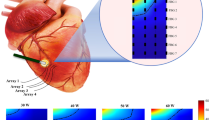Abstract
Precise temperature control and temperature distribution prediction are of great significance for radiofrequency ablation. This research proposes a real-time calculation method for the temperature distribution of radiofrequency ablation combined with proportional-integral temperature control. The thermo-electrical coupling was simplified into a linear relationship based on the study of the influence of temperature-dependent electrical conductivity and thermal conductivity on the PI-controlled radiofrequency ablation temperature distribution, which increases the computational efficiency by 150 times. The average calculation time for radiofrequency ablation of 10min is about 23 s, and the difference between the calculation results of this method and that from COMSOL Multiphysics is no more than 1 °C. This method is not only used for single-probe, but also for double-probe radiofrequency ablation in this paper.
摘要
精确的温度控制和温度场预测对射频消融具有重要意义, 本研究提出了一种比例-积分温度控制射频消融过程中的温度场实时计算方法, 基于电导率对温控射频消融影响的研究, 将热电耦合的计算关系转换为线性的计算关系, 使计算效率提升了150倍. 对于10 min的射频消融, 计算时间约为23 s, 计算结果和相同情况下的COMSOL Multiphysics相比不超过1 °C. 本研究中该计算方法不仅被用于单针射频消融, 还被用于双针射频消融中温度场的计算.
Similar content being viewed by others
References
SCHULLIAN P, PUTZER D, EBERLE G, et al. Simultaneous stereotactic radiofrequency ablation of multiple (⩾ 4) liver tumors: Feasibility, safety, and efficacy [J]. Journal of Vascular and Interventional Radiology, 2020, 31(6): 943–952.
TANG R B, WANG C C. Numerical simulation of tissue-equivalent material experiments for radio frequency hyperthermia of tumors [J]. Journal of Tsinghua University (Science and Technology), 2002, 42(5): 676–679 (in Chinese).
SAMSET E. Temperature mapping of thermal ablation using MRI [J]. Minimally Invasive Therapy & Allied Technologies, 2006, 15(1): 36–41.
CHEN R D, LU F, WU F, et al. An analytical solution for temperature distributions in hepatic radiofrequency ablation incorporating the heat-sink effect of large vessels [J]. Physics in Medicine and Biology, 2018, 63(23): 235026.
MOLINA J A L, RIVERA M J, BERJANO E. Analytical transient-time solution for temperature in non perfused tissue during radiofrequency ablation [J]. Applied Mathematical Modelling, 2017, 42: 618–635.
HAEMMERICH D, CHACHATI L, WRIGHT A S, et al. Hepatic radiofrequency ablation with internally cooled probes: Effect of coolant temperature on lesion size [J]. IEEE Transactions on Bio-Medical Engineering, 2003, 50(4): 493–500.
LU X W, KIKUCHI H, HIROOKA K, et al. Method for estimating the temperature distribution associated with the vessel cooling effect in radio frequency ablation [C]//2015 37th Annual International Conference of the IEEE Engineering in Medicine and Biology Society. Milan, Italy: IEEE, 2015: 4836–4839.
OOI E H, LEE K W, YAP S, et al. The effects of electrical and thermal boundary condition on the simulation of radiofrequency ablation of liver cancer for tumours located near to the liver boundary [J]. Computers in Biology and Medicine, 2019, 106: 12–23.
AUDIGIER C, MANSI T, DELINGETTE H, et al. Efficient lattice Boltzmann solver for patient-specific radiofrequency ablation of hepatic tumors [J]. IEEE Transactions on Medical Imaging, 2015, 34(7): 1576–1589.
HE Z Z, LIU J. An efficient thermal evolution model for cryoablation with arbitrary multi-cryoprobe configuration [J]. Cryobiology, 2015, 71(2): 318–328.
ZORBAS G, SAMARAS T. Parametric study of radiofrequency ablation in the clinical practice with the use of two-compartment numerical models [J]. Electromagnetic Biology and Medicine, 2013, 32(2): 236–243.
DOSS J D. Calculation of electric fields in conductive media [J]. Medical Physics, 1982, 9(4): 566–573.
PENNES H H. Analysis of tissue and arterial blood temperatures in the resting human forearm [J]. Journal of Applied Physiology, 1998, 85(1): 5–34.
ZHENG Y B, ZHANG K W, ZOU J C, et al. An noninvasive and impedance-ignored control strategy of the ablation zone in radiofrequency ablation therapy [C]//2019 41st Annual International Conference of the IEEE Engineering in Medicine and Biology Society. Berlin, Germany: IEEE, 2019: 5514–5517.
TRUJILLO M, BERJANO E. Review of the mathematical functions used to model the temperature dependence of electrical and thermal conductivities of biological tissue in radiofrequency ablation [J]. International Journal of Hyperthermia, 2013, 29(6): 590–597.
CHANG I. Finite element analysis of hepatic radiofrequency ablation probes using temperature-dependent electrical conductivity [J]. Biomedical Engineering Online, 2003, 2: 12.
Acknowledgment
The author thanks Magi Company Ltd. for providing the experimental device.
Author information
Authors and Affiliations
Corresponding author
Additional information
Foundation item: the National Natural Science Foundation of China (No. 51890892)
Rights and permissions
About this article
Cite this article
Wang, X., Wang, Y. & Zhang, A. Real-Time Calculation Method for Temperature Distribution of Temperature-Controlled Radiofrequency Ablation. J. Shanghai Jiaotong Univ. (Sci.) 28, 411–417 (2023). https://doi.org/10.1007/s12204-022-2481-y
Received:
Accepted:
Published:
Issue Date:
DOI: https://doi.org/10.1007/s12204-022-2481-y



